The underwater bikes market is estimated to be valued at USD 352.0 million in 2025 and is projected to reach USD 463.9 million by 2035, registering a CAGR of 2.8% over the forecast period. Growth is influenced by the rising adoption of aquatic fitness solutions, rehabilitation therapies, and wellness programs in health clubs and physiotherapy centers. Underwater bikes are being integrated into hydrotherapy routines due to their low-impact exercise benefits, which help improve cardiovascular health, muscle strength, and joint flexibility. The appeal extends to senior populations and individuals recovering from orthopedic injuries, where water resistance provides a safer training environment. Manufacturers are introducing ergonomic designs with adjustable resistance settings, durable materials, and compact frames suited for pools and wellness facilities. Expansion in luxury hotels, spas, and rehabilitation centers has supported wider availability, while the premium nature of these products continues to limit penetration in cost-sensitive regions. Europe remains the largest market due to established wellness infrastructure, while Asia Pacific is emerging with rising interest in fitness tourism and rehabilitation-driven demand.
Quick Stats for Underwater Bikes Market
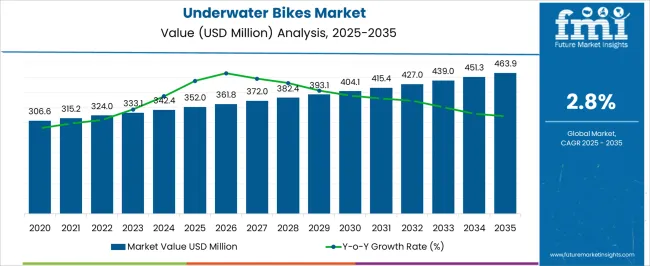
| Metric | Value |
|---|---|
| Underwater Bikes Market Estimated Value in (2025 E) | USD 352.0 million |
| Underwater Bikes Market Forecast Value in (2035 F) | USD 463.9 million |
| Forecast CAGR (2025 to 2035) | 2.8% |
The underwater bikes market is witnessing rapid momentum due to rising health consciousness, growing popularity of aqua fitness, and expanding interest in unique personal wellness experiences. Consumers are increasingly adopting water-based workouts for their low-impact and joint-friendly benefits, especially among aging populations and rehabilitation patients.
Technological advancements in underwater propulsion, material durability, and ergonomic designs are enhancing both safety and user experience. Fitness centers, luxury resorts, and personal buyers are integrating these bikes into aquatic therapy and recreational setups.
With the intersection of health, sustainability, and innovation, the market is expected to flourish in diverse end-use environments.
The underwater bikes market is segmented by type, application, end use, and geographic regions. By type, underwater bikes market is divided into Electric and Manual. In terms of application, underwater bikes market is classified into Fitness Training, Recreational, and Research. Based on end use, underwater bikes market is segmented into Personal and Commercial. Regionally, the underwater bikes industry is classified into North America, Latin America, Western Europe, Eastern Europe, Balkan & Baltic Countries, Russia & Belarus, Central Asia, East Asia, South Asia & Pacific, and the Middle East & Africa.
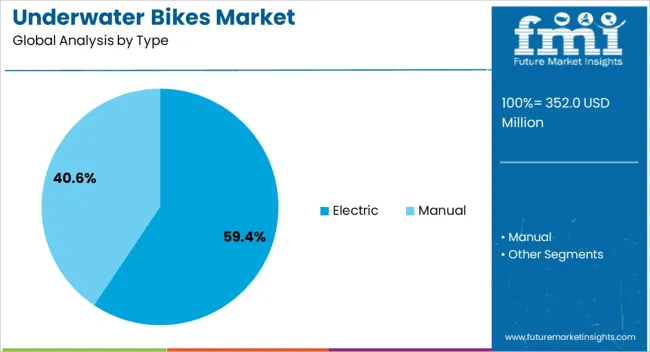
The electric segment is projected to lead the underwater bikes market with a 59.40% share by 2025. Electric underwater bikes are gaining popularity due to their propulsion assistance, allowing users to control intensity and duration of underwater exercise with ease.
These models are especially favored by users with limited mobility or those undergoing physical rehabilitation. Additionally, electric variants enhance safety and user confidence, making underwater biking accessible to a broader demographic.
The convenience, performance customization, and rising innovation in waterproof motor systems are accelerating adoption of electric units across both commercial and personal applications.
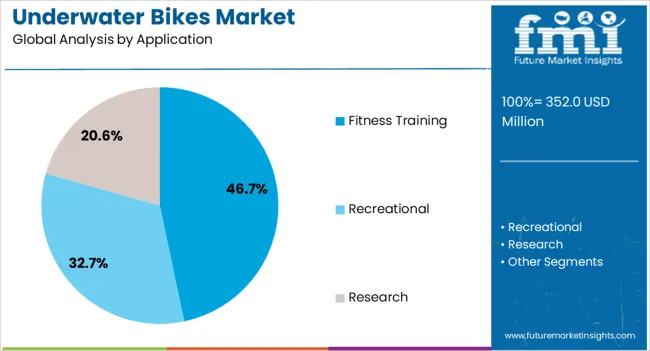
Fitness training is expected to account for 46.70% of the market share in 2025, making it the dominant application segment. This growth is driven by increased incorporation of aqua cycling in gyms, rehabilitation centers, and wellness retreats.
The low-impact nature of underwater biking is ideal for cardiovascular conditioning, weight loss, and muscle toning without joint stress. Moreover, structured aquatic training programs and the inclusion of underwater bikes in boutique fitness classes are boosting visibility and demand.
As wellness culture continues to prioritize functional and injury-preventive exercise, the role of underwater bikes in training routines is set to expand further.
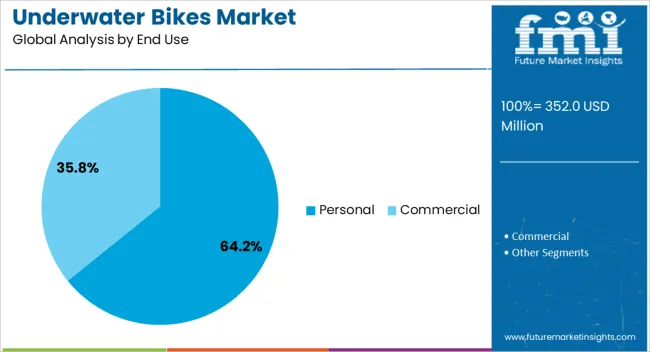
The personal segment is anticipated to lead the market with a 64.20% share by 2025, driven by growing interest in private aquatic wellness and home-based exercise options. High-income consumers and health enthusiasts are increasingly installing underwater bikes in residential pools to support flexible and convenient fitness routines.
The ability to exercise in a controlled, private aquatic environment is appealing, especially post-pandemic. Product innovations, including lightweight designs, easy storage, and user-friendly resistance settings, have made underwater bikes more attractive for personal buyers.
With expanding awareness and affordability, personal adoption is expected to remain the primary revenue driver in this market.
The underwater bikes market is being driven by growing adoption of aquatic exercise in fitness clubs, rehabilitation centers, and wellness facilities. Water-based cycling provides low-impact cardiovascular training that reduces stress on joints while improving muscle tone and endurance. Physiotherapists increasingly prescribe hydrotherapy with underwater bikes for post-injury recovery, arthritis management, and mobility improvement in seniors. Rising interest in premium fitness offerings at luxury hotels, spas, and resorts has further fueled uptake. Expanding awareness of water resistance training benefits and its role in lifestyle wellness programs continues to strengthen long-term demand.
Despite its therapeutic benefits, the underwater bikes market faces constraints due to high product costs and limited facility availability. Specialized pool equipment requires significant investment, restricting adoption in cost-sensitive regions. Maintenance, installation, and space requirements add to operational expenses for gyms and rehabilitation centers. Consumer awareness remains low outside urban wellness hubs, creating slower market penetration. These challenges make underwater bikes more common in premium fitness chains and medical facilities rather than mass-market settings, narrowing growth opportunities in emerging economies.
Manufacturers are focusing on ergonomic improvements, corrosion-resistant materials, and adjustable resistance systems to enhance user experience. Compact and foldable underwater bikes are being introduced for space-efficient pool use. Integration of digital monitoring systems, including resistance tracking and performance feedback, reflects the shift toward connected fitness. Wellness tourism is becoming a strong trend, with luxury resorts and rehabilitation centers offering aquatic fitness experiences as part of holistic health packages. The combination of premium fitness demand, therapeutic applications, and innovative product launches is shaping the market’s future trajectory.
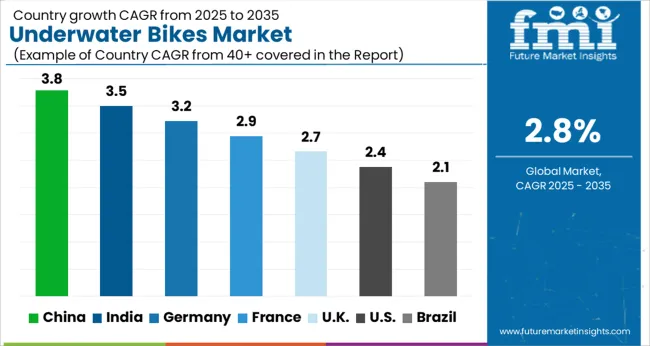
| Country | CAGR |
|---|---|
| China | 3.8% |
| India | 3.5% |
| Germany | 3.2% |
| France | 2.9% |
| UK | 2.7% |
| USA | 2.4% |
| Brazil | 2.1% |
China’s underwater bikes market is expected to grow at a CAGR of 3.8%, supported by increasing investment in health and rehabilitation facilities. Rising urban incomes and stronger focus on fitness lifestyles have accelerated adoption across wellness centers, aquatic gyms, and luxury hotels. Domestic manufacturers are introducing durable stainless-steel frames and corrosion-resistant coatings to meet pool safety requirements. Expansion of physiotherapy centers is also strengthening demand, particularly for post-injury rehabilitation and elderly care. Distribution networks have improved access in tier-one and tier-two cities, with partnerships established between suppliers and wellness operators. Government initiatives promoting public health infrastructure are expected to complement growth in the long term.
Expansion of physiotherapy and rehabilitation centers
Domestic production emphasizes durable, corrosion-resistant materials
Distribution extends into tier-one and tier-two urban markets
India’s underwater bikes market is projected to grow at a CAGR of 3.5%, fueled by increasing awareness of hydrotherapy benefits and growing wellness tourism. The rising middle-class population is showing interest in premium fitness solutions offered at luxury spas and hotels. Rehabilitation centers are gradually adopting underwater bikes to support arthritis therapy, post-surgery recovery, and geriatric care. Manufacturers are working with local distributors to make compact, cost-efficient models available in urban wellness hubs. Online platforms and specialty fitness equipment retailers have helped expand visibility, though affordability remains a barrier for widespread adoption. The market is supported by a growing culture of recreational fitness activities and demand for specialized therapy options in major cities.
Wellness tourism and luxury spas driving adoption
Compact, cost-efficient models gaining traction in urban areas
Rehabilitation use for arthritis and post-surgery recovery
Germany’s underwater bikes market is expected to expand at a CAGR of 3.2%, backed by stringent quality benchmarks and high acceptance of water-based rehabilitation therapies. German clinics and physiotherapy centers have integrated underwater bikes into recovery programs for orthopedic injuries and cardiovascular therapy. Premium fitness clubs and wellness resorts also feature aquatic cycling as part of holistic health packages. Manufacturers are investing in advanced ergonomics, adjustable resistance systems, and digital tracking capabilities to meet local consumer expectations. Eco-friendly materials and sustainable production processes are becoming important selling points in this market. Established supply chains and specialized distributors ensure product availability across medical and fitness institutions.
Advanced rehabilitation programs adopt aquatic bikes
Premium resorts integrate underwater cycling in wellness offerings
Focus on eco-friendly, durable, and digitally enabled models
France’s underwater bikes market has been recorded at a CAGR of 2.9%, reflecting consistent demand from spa facilities, luxury hotels, and healthcare providers. The country has a well-established tradition of hydrotherapy and balneotherapy, supporting integration of underwater cycling into wellness treatments. Fitness studios and rehabilitation centers increasingly use these bikes for low-impact cardiovascular workouts and physiotherapy. Manufacturers focus on sleek, space-efficient designs to cater to compact urban pools. Retailers emphasize premium features such as adjustable resistance, ergonomic seats, and anti-corrosion finishes. Seasonal demand is supported by the strong spa tourism sector, while healthcare professionals endorse underwater cycling for its therapeutic benefits, especially among senior citizens.
Long-standing culture of hydrotherapy supports adoption
Space-efficient designs suited for urban wellness facilities
Endorsement from healthcare professionals for rehabilitation use
The United Kingdom’s underwater bikes market is projected to grow at a CAGR of 2.7%, supported by demand from healthcare systems, luxury resorts, and fitness clubs. NHS-backed rehabilitation programs are gradually recognizing aquatic therapies, enhancing adoption in clinical environments. Private health clubs and high-end hotels integrate underwater cycling into wellness packages aimed at premium consumers. Manufacturers highlight ergonomic adjustments, portability, and digital feedback systems to attract professional buyers. E-commerce and specialty distributors improve product access, though penetration remains strongest in metropolitan areas. Awareness campaigns on aquatic exercise benefits are expanding user acceptance, particularly among seniors seeking joint-friendly training methods. Overall growth is expected to be steady, with opportunities tied to premium wellness and rehabilitation services.
NHS-backed rehabilitation programs encourage adoption
High-end hotels and clubs integrate aquatic fitness offerings
Seniors show growing interest in joint-friendly cycling options
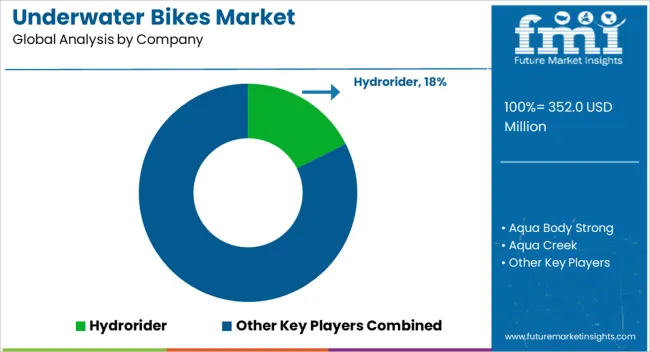
The competitive landscape of the underwater bikes market is defined by a mix of specialized wellness equipment manufacturers, fitness solution providers, and regional distributors catering to hydrotherapy demand. Leading players focus on premium product development with corrosion-resistant materials, ergonomic seating, and adjustable resistance systems that suit both rehabilitation and recreational use. European firms dominate due to the region’s strong spa and wellness infrastructure, with brands marketing their products as luxury fitness and therapeutic tools. In Asia, domestic producers are increasingly introducing cost-optimized models to capture emerging demand in urban wellness hubs. Partnerships with luxury hotels, physiotherapy centers, and aquatic fitness studios form a central strategy for expanding reach.
Differentiation is achieved through design innovation, compact formats for smaller pools, and integration of digital monitoring features that align with connected fitness trends. Competition is intensifying as wellness tourism accelerates and rehabilitation programs adopt aquatic cycling more widely. Branding, after-sales support, and distributor partnerships remain critical factors, with manufacturers emphasizing safety standards and product durability to strengthen positioning across diverse regional markets.
| Item | Value |
|---|---|
| Quantitative Units | USD 352.0 Million |
| Type | Electric and Manual |
| Application | Fitness Training, Recreational, and Research |
| End Use | Personal and Commercial |
| Regions Covered | North America, Europe, Asia-Pacific, Latin America, Middle East & Africa |
| Country Covered | United States, Canada, Germany, France, United Kingdom, China, Japan, India, Brazil, South Africa |
| Key Companies Profiled | Hydrorider, Aqua Body Strong, Aqua Creek, Dynamika, Fitmax, Hexagone Manufacture, itBike, New Atlas, POOLBIKING, and Schiller Bikes |
| Additional Attributes | Dollar sales by type including pedal-powered, electric, and hybrid bikes, application across recreational tourism, underwater exploration, and research activities, and region covering North America, Europe, and Asia-Pacific. Growth is driven by rising interest in adventure tourism, increasing underwater recreational activities, and advancements in submersible transportation technology. |
The global underwater bikes market is estimated to be valued at USD 352.0 million in 2025.
The market size for the underwater bikes market is projected to reach USD 463.9 million by 2035.
The underwater bikes market is expected to grow at a 2.8% CAGR between 2025 and 2035.
The key product types in underwater bikes market are electric and manual.
In terms of application, fitness training segment to command 46.7% share in the underwater bikes market in 2025.






Our Research Products

The "Full Research Suite" delivers actionable market intel, deep dives on markets or technologies, so clients act faster, cut risk, and unlock growth.

The Leaderboard benchmarks and ranks top vendors, classifying them as Established Leaders, Leading Challengers, or Disruptors & Challengers.

Locates where complements amplify value and substitutes erode it, forecasting net impact by horizon

We deliver granular, decision-grade intel: market sizing, 5-year forecasts, pricing, adoption, usage, revenue, and operational KPIs—plus competitor tracking, regulation, and value chains—across 60 countries broadly.

Spot the shifts before they hit your P&L. We track inflection points, adoption curves, pricing moves, and ecosystem plays to show where demand is heading, why it is changing, and what to do next across high-growth markets and disruptive tech

Real-time reads of user behavior. We track shifting priorities, perceptions of today’s and next-gen services, and provider experience, then pace how fast tech moves from trial to adoption, blending buyer, consumer, and channel inputs with social signals (#WhySwitch, #UX).

Partner with our analyst team to build a custom report designed around your business priorities. From analysing market trends to assessing competitors or crafting bespoke datasets, we tailor insights to your needs.
Supplier Intelligence
Discovery & Profiling
Capacity & Footprint
Performance & Risk
Compliance & Governance
Commercial Readiness
Who Supplies Whom
Scorecards & Shortlists
Playbooks & Docs
Category Intelligence
Definition & Scope
Demand & Use Cases
Cost Drivers
Market Structure
Supply Chain Map
Trade & Policy
Operating Norms
Deliverables
Buyer Intelligence
Account Basics
Spend & Scope
Procurement Model
Vendor Requirements
Terms & Policies
Entry Strategy
Pain Points & Triggers
Outputs
Pricing Analysis
Benchmarks
Trends
Should-Cost
Indexation
Landed Cost
Commercial Terms
Deliverables
Brand Analysis
Positioning & Value Prop
Share & Presence
Customer Evidence
Go-to-Market
Digital & Reputation
Compliance & Trust
KPIs & Gaps
Outputs
Full Research Suite comprises of:
Market outlook & trends analysis
Interviews & case studies
Strategic recommendations
Vendor profiles & capabilities analysis
5-year forecasts
8 regions and 60+ country-level data splits
Market segment data splits
12 months of continuous data updates
DELIVERED AS:
PDF EXCEL ONLINE
Underwater Light Market Size and Share Forecast Outlook 2025 to 2035
Underwater Hotel Market Forecast and Outlook 2025 to 2035
Underwater Welding Consumable Market Size and Share Forecast Outlook 2025 to 2035
Underwater Modems Market Size and Share Forecast Outlook 2025 to 2035
Underwater Pelletizing Market Size and Share Forecast Outlook 2025 to 2035
Underwater Connectors Market Size and Share Forecast Outlook 2025 to 2035
Underwater Camera Market Size and Share Forecast Outlook 2025 to 2035
Underwater Acoustic Communication Market Growth - Trends & Forecast 2025 to 2035
Underwater Welding Equipment Market Growth – Trends & Forecast 2024-2034
BMX Bikes Market Size and Share Forecast Outlook 2025 to 2035
Hydrobikes Market Size and Share Forecast Outlook 2025 to 2035
Sales of Used Bikes through Bike Marketplaces Market- Growth & Demand 2025 to 2035
Electric 3-wheeler Cargo Bikes Market Size and Share Forecast Outlook 2025 to 2035

Thank you!
You will receive an email from our Business Development Manager. Please be sure to check your SPAM/JUNK folder too.
Chat With
MaRIA